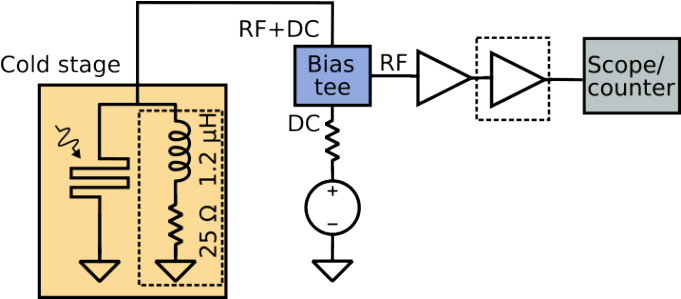
New publication: Emma Batson, Francesca Incalza, Matteo Castellani, Marco Colangelo, Ilya Charaev, Andreas Schilling, Sergey Cherednichenko, and Karl K. Berggren. “Effects of Helium Ion Exposure on the Single-Photon Sensitivity of MgB₂ and NbN Detectors,” IEEE Transactions on Applied Superconductivity, (2024).
Caption: The readout electronics setups for magnesium diboride wires and niobium nitride wires were nearly identical, with optional components shown in dashed lines. A cold-stage off-chip shunt was necessary to prevent latching in the wide magnesium diboride wires. Bias current was provided by a voltage source and a 1 kΩ resistor for the wide magnesium diboride wires or a 10 kΩ resistor for the narrow NbN wires. At low temperatures in the wide wires, only one stage of amplification was necessary. Detectors were illuminated with a 1550 nm laser (magnesium diboride) or 780 nm laser (niobium nitride) through a fiber-optic cable.
Abstract
Improving the scalability, reproducibility, and operating temperature of superconducting nanowire single photon detectors (SNSPDs) has been a major research goal since the devices were first proposed. The recent innovation of helium-ion irradiation as a post-processing technique for SNSPDs could enable high detection efficiencies to be more easily reproducible, but is still poorly understood. Additionally, fabricating detectors at micron-wide scales from high-T_C materials could improve scalability and operating temperature, respectively. At the same time, fabrication of successful devices in wide wires and from higher-T_C materials like magnesium diboride has proven challenging. In this work, we compare helium ion irradiation in niobium nitride and magnesium diboride detectors with different material stacks in order to better understand the mechanics of irradiation and practical implications of encapsulating layers on effective dose. We examine the effects of experimental effective dose tests and compare these results to the damage per ion predicted by simulations in corresponding material stacks. In both materials, irradiation results in an increase in count rate, though for niobium nitride this increase has not fully saturated even at the highest tested dose of 2.6×1017 ions/cm^2 , while for resist-encapsulated magnesium diboride even the lowest tested dose of 1×1015 ions/cm^2 appears higher than optimal. Our results demonstrate the general applicability of helium ion irradiation to vastly different devices and material stacks, albeit with differing optimal doses, and show the reproducibility and effectiveness of this post-processing technique in significantly improving SNSPD efficiency.
The pdf can be accessed here, under the following copyright understanding: “© 20XX IEEE. Personal use of this material is permitted. Permission from IEEE must be obtained for all other uses, in any current or future media, including reprinting/republishing this material for advertising or promotional purposes, creating new collective works, for resale or redistribution to servers or lists, or reuse of any copyrighted component of this work in other works.”